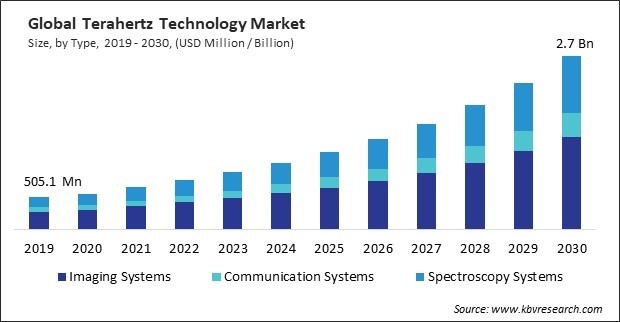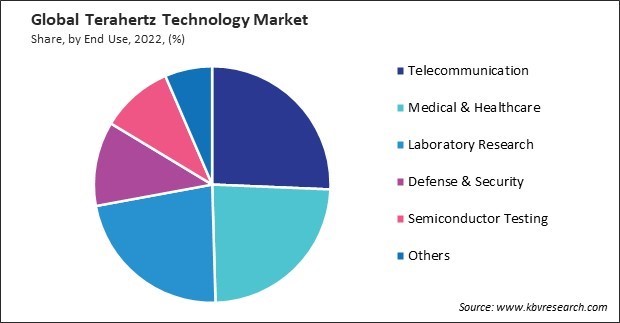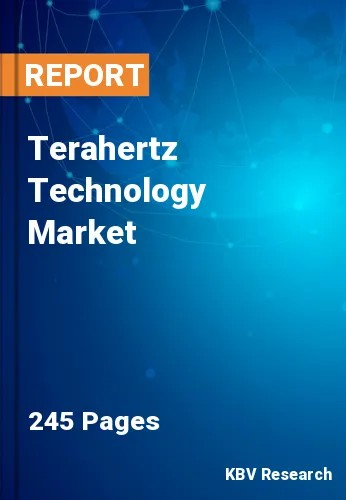“Global Terahertz Technology Market to reach a market value of USD 2.7 Billion by 2030 growing at a CAGR of 17.1%”
The Global Terahertz Technology Market size is expected to reach $2.7 billion by 2030, rising at a market growth of 17.1% CAGR during the forecast period.
Antennas in terahertz systems are essential for imaging applications, such as medical imaging and security screening. Consequently, the antennas segment captured $77.79 million revenue in the market in 2022. Terahertz antennas can facilitate short-range, point-to-point communication links. These benefits applications requiring high data transfer rates in localized areas, such as indoor communication systems or data center networks. Terahertz antennas enable the capture of high-resolution images, making them valuable for detailed inspections and diagnostics.

There is a heightened need for advanced technologies to detect concealed threats effectively with evolving security threats. Terahertz waves can penetrate clothing and non-metallic materials, enabling the detection of concealed objects that traditional security screening methods may miss. THz scanners provide high-resolution images for enhanced threat detection. Terahertz waves are non-ionizing and pose no known health risks. Additionally, the aerospace industry demands stringent quality control measures to ensure the safety and reliability of components and structures. Terahertz technology effectively inspects composite materials used in aircraft structures without causing damage. It contributes to quality control by identifying hidden defects or inconsistencies. The oil and gas industry needs non-destructive testing methods to assess the integrity of pipelines and detect potential issues. Terahertz technology can contribute to inspecting pipelines for corrosion, structural defects, or material degradation without physical intrusion. Thus, because of the increasing demand for NDT, the terahertz technology market is anticipated to increase significantly.
However, the absence of standardized testing and measurement methods leads to inconsistency in how terahertz technology is implemented and assessed across different applications and industries. This lack of uniformity hampers reliable comparisons and benchmarking. Industries and applications using terahertz technology often face challenges in complying with regulations due to the absence of clear standards. Standardization is crucial in ensuring the quality and reliability of terahertz devices and applications. Without standardized testing procedures, there may be concerns about the accuracy and consistency of results obtained using THz technology. The absence of standardization may lead to delays in innovation and research efforts. Researchers may face challenges in establishing a common foundation for experimentation, hindering the development of new applications and technologies. Therefore, lack of standardization is a significant challenge that hampers the growth of terahertz technology market.
On the basis of end use, the terahertz technology market is divided into telecommunication, medical & healthcare, laboratory research, defense & security, semiconductor testing, and others. In 2022, the telecommunication segment dominated the terahertz technology market with maximum revenue share. Terahertz technology can be crucial in developing networks beyond 5G and 6G. Terahertz frequencies are expected to facilitate high data rates, minimal latency, and widespread device connectivity. They can also aid in the development of future communications standards. Terahertz frequencies can be used in the wireless backhaul segment, connecting the core network to individual base stations. This can support high-capacity and low-latency communication, contributing to the efficiency of telecommunication networks.

By type, the terahertz technology market is categorized into imaging systems, communication systems, and spectroscopy systems. The communication systems segment covered a considerable revenue share in the terahertz technology market in 2022. Terahertz technology can be employed for short-range, high-bandwidth communication within data centers. This can facilitate faster and more efficient data transfer between servers and other components. Terahertz communication can complement existing millimeter-wave technologies, extending the available spectrum and enabling more devices to communicate simultaneously without interference.
Based on application, the terahertz technology market is classified into imaging scanner, imaging cameras, antennas, spectrometer, and body scanner. In 2022, the imaging cameras segment witnessed the largest revenue share in the terahertz technology market. Terahertz imaging cameras aid in the planning and optimization of wireless communication networks by visualizing signal coverage, interference, and potential obstacles. Terahertz imaging technology can be integrated into consumer electronics, such as smartphones and smart home devices, for advanced gesture recognition and touchless interactions.
Free Valuable Insights: Global Terahertz Technology Market size to reach USD 2.7 Billion by 2030
Region-wise, the terahertz technology market is analysed across North America, Europe, Asia Pacific, and LAMEA. In 2022, the North America region led the terahertz technology market by generating the highest revenue share. This technology may be explored in North America to enhance security screening at airports, public events, and critical infrastructure. The region’s advanced healthcare sector may lead to research and development in terahertz medical imaging. North America has been a leader in developing and deploying advanced telecommunication technologies. The region fosters innovation through startups and collaborations between industry and academia.
| Report Attribute | Details |
|---|---|
| Market size value in 2022 | USD 772.1 Million |
| Market size forecast in 2030 | USD 2.7 Billion |
| Base Year | 2022 |
| Historical Period | 2019 to 2021 |
| Forecast Period | 2023 to 2030 |
| Revenue Growth Rate | CAGR of 17.1% from 2023 to 2030 |
| Number of Pages | 245 |
| Number of Tables | 400 |
| Report coverage | Market Trends, Revenue Estimation and Forecast, Segmentation Analysis, Regional and Country Breakdown, Porter’s 5 Forces Analysis, Company Profiling, Companies Strategic Developments, SWOT Analysis, Winning Imperatives |
| Segments covered | Type, Application, End Use, Region |
| Country scope |
|
| Companies Included | Terasense Group Inc., Virginia Diodes, Inc., TeraView Limited, Lytid SAS, HÜBNER GmbH & Co. KG, Advantest Corporation, BATOP GmbH, Menlo Systems GmbH, Gentec Electro-Optics, Inc. (Gentec Inc.), TOPTICA Photonics AG |
By End Use
By Type
By Application
By Geography
This Market size is expected to reach $2.7 billion by 2030.
Growing need for enhanced security solutions are driving the Market in coming years, however, Lack of standardization in terahertz technology restraints the growth of the Market.
Terasense Group Inc., Virginia Diodes, Inc., TeraView Limited, Lytid SAS, HÜBNER GmbH & Co. KG, Advantest Corporation, BATOP GmbH, Menlo Systems GmbH, Gentec Electro-Optics, Inc. (Gentec Inc.), TOPTICA Photonics AG
The expected CAGR of this Market is 17.1% from 2023 to 2030.
The Imaging Systems segment is generating the highest revenue in the Market by Type in 2022; there by, achieving a market value of $1.4 Billion by 2030.
The North America region dominated the Market by Region in 2022, and would continue to be a dominant market till 2030; there by, achieving a market value of $925.6 Million by 2030.
Our team of dedicated experts can provide you with attractive expansion opportunities for your business.

 Drivers
Drivers
 Restraints
Restraints
 Opportunities
Opportunities
 Challenges
Challenges
